
TECHNOLOGIES
Arvind Envisol has the Infrastructure proprietary technologies needed for cost-effective water treatment including recycling and recovery.
Our water conservation solutions are being used by major industries around the world for industrial, commercial, and municipal applications.
Water optimization is a critical component of all modern establishments given the urgent need to save and recover water. We
have the technologies coupled with the know-how and experience to provide customized wastewater treatment solutions.
- Waste Water Primary Treatment
- Secondary/Biological Treatment
- Tertiary Treatment
- Evaporators
- Sludge Management Technologies
- Drying Technologies
SLUDGE DEWATERING
The sludge resulting from wastewater treatment operations and processes is usually in the form of a liquid or a semisolid liquid that typically contains 0.25-12% solids by weight, depending upon the operations and processes used. The volume of sludge is larger and hence it’s processing and disposal is perhaps the most complex problem due to the presence of the organic matter present in it at the end of biological treatment. In Sludge Dewatering different operations are performed on the sludge to provide a relatively constant, homogeneous feed to sludge processing facilities.
Technologies which can be used to treat the sludge are-
Filter press
Belt press
Screw press
Centrifuge
Anaerobic digester
Screw dehydrator
Filter press
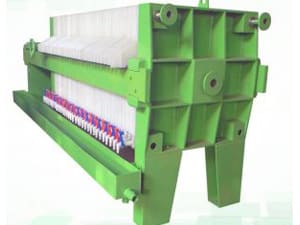
Filter Press is a dewatering unit which is used to reduce the moisture content of the sludge and biosolids.
The fixed volume, recessed plate filter press consists of series of square plates, recessed on both sides that are supported face to face in a vertical position on a frame with a fixed and movable head.
A filter cloth is hung or fitted over each plate. The plates are held together with sufficient force to seal them to withstand the pressure applied during the filtration process.
In operation, chemically conditioned sludge is pumped into the space between the plates and pressure of 100 to 225 lbf/in 2 is applied and maintained for 1 to 3 hr forcing the liquid through the filter cloth and plate outlet ports.
The plates are then separated and cake is removed. The sludge cake thickness which varies from 25-45 mm and the moisture content of the cake varies from 48-70%.
Belt press
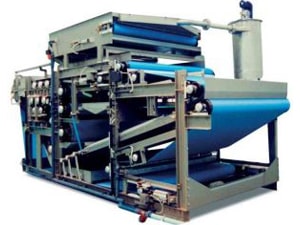
Belt filter allow continuous sludge dewatering between two filter belts. It has different zones through which sludge passes.
Flocculator: The sludge flocculent blend is done in the flocculator and then flocculated sludge is evenly distributed on the filter belt.
The inlet stream is stilled upon entry into the clarifier. Hoppers are kept at the bottom of the clarifier to collect the solid particles which are settling down and the clarified liquid exits.
A gravity drainage zone: The sludge is drained on the first belt while the drainage is helped by the picket fences which are lying freely on the belt Water line is created and the majority of the water by flocculation is eliminated.
Water line is created and the majority of the water by flocculation is eliminated.
A progressive compression zone: The sludge, after drainage of the water freed by flocculation, is then pressed between two filter belts. With the arrival of the top belt, a progressive pressurization takes place:
Up to 4 bars for low-pressure belt filters.
Up to 5 bars for medium pressure belt filters.
Up to 7 bars for high-pressure belt filters.
A cake scraping zone: Once pressed, the sludge has a more solid aspect. It is called a sludge cake or simply cake. This cake is then scraped off from the surface of the two belts that separate at this level.
A high-pressure washing station: A bank of nozzles under 7 to 8 bars (100 to 120 PSI) continuously cleans each belt.
Screw press
Screw press is a type of machine in which a ram is driven up and down by the screw. It uses a coarse screw to convert the rotation of the lever into the downward force. The lever usually incorporates balls as flyweights. These weights help to maintain the momentum and thrust of the tool to make it easier to operate.
Centrifuge
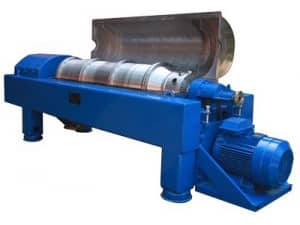
The principle of the centrifuge, also known as centrifugal decanter, is to use centrifugal force to accelerate the solid-liquid separation.
A centrifuge is a conical cylinder decanter that turns horizontally on its axis with a clarified water overflow, and the dewatered sludge being removed by an Archimedean screw. The rotation applies a centrifugal force on the solid particles which then moves a lot more quickly.
The flocculated sludge is injected inside the centrifuge bowl through an injection pipe. The bowl has a high rotation speed and the particles are flattened against the bowl’s sides in the clarification zone.
These particles are then pushed by an Archimedean screw towards the end of the bowl’s cone in the sludge spin-dry zone.
The clarified liquid called centrate, is evacuated at the other end of the bowl by overflow.
Anaerobic digester
Digestion is a biological process in which organic solids are decomposed into stable substances. It reduces the total mass of solids by decomposing volatiles present in sludge and makes it easier to dewater or dry sludge. Volatile matter gets converted into hydrocarbon gas which can be used for any thermal application.
Attributes of Anaerobic digestion:
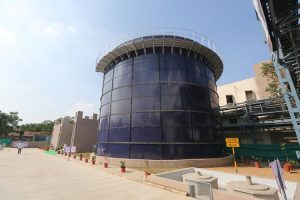
Objective is to minimize SRT (Sludge Retention Time) required to achieve maximum VSS (Volatile Suspended Solid) destruction
Operating temperatures for digestion are usually between 30 – 45 degree celcius
Single stage high rate digestion is preferred where retention time for concentrated sludge is between 10 – 20 days
Thickening of sludge is required to increase SRT and hence increases production of digestion gas
The digested sludge is about half as concentrated as the untreated sludge feed leading to reduction in volatile content and hence reduces handling cost
Sludge is mixed with the help of external recirculation system made up of draft tubes, the arrangement is easier to maintain, provides better mixing control and recirculation of scum layer and sludge deposits
Digested gas contains 65 – 70% methane by volume and typically vary from 0.75 – 1.12 m3/kg of volatile solids destroyed
Anaerobic v/s Aerobic digester:
Aerobic digestion only works with waste activated sludge or mixture of waste activated or trickling filter sludge and primary sludge.
High power cost associated with supplying required oxygen to the aerobic digester
Digested bio solids produced have poorer mechanical dewatering characteristics
Process gets affected significantly by temperature, location, tank geometry and concentration of feed solids
Methane cannot be recovered from anaerobic digester for thermal application
Screw dehydrator
As a new member of screw press, comprises of fixed ring, moving ring and a screw which thrusts the filter element and transfers & pressurizes sludge. The gaps between the rings and the screw pitch are designed to gradually get narrower towards the direction of sludge cake outlet and the inner pressure of the filter element increases due to the volume compression effect, which thickens and dewaters the sludge.
Designed for various slurry applications in Effluent and Sewage treatment plants
Attributes of Screw dehydrator:
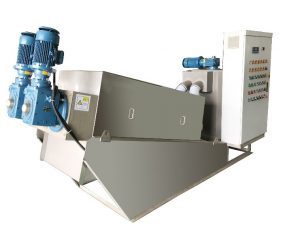
Versatile in solid handling from 0.8% to 5% solids in slurry
Can reduce need of sedimentation and thickening tank
It can replace filter press, belt press, decanters and other dewatering technologies
Rotation of screw is a very low speed, hence leading to low power and water consumption
Single skid comprises of slurry storage, flocculation tank, dehydrator zone and dosing system
Once started, the system can run unattended and can be set to shutdown automatically with no operator intervention
Application overview

Type of sludge SCREW DEHYDRATOR can handle are:
Primary sludge
Waste activated sludge
Trickling filter secondary sludge
Secondary sludge
Digested sludge
Aeration sludge, and
Tertiary sludge
Differentiating factor:
Advantages of using AEL screw dehydrator are as follows:
Low power consumption and foot print
Reduction in investment cost for thickening and storage equipment
Fully automatic control
Can dewater oily sludge
No skill worker required
Minimum wash water requirement, and various other benefits which can be seen in below comparison chart
